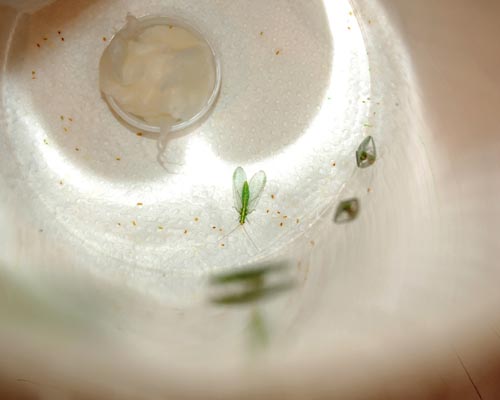IOBC/WPRS Guideline (2000): Ladybird beetle – Coccinella septempunctata
The foliage dwelling insect Chrysoperla carnea is recommended as additional specie where the in-field or off-field risk assessment for the 2 standard species fails.
First instar larvae of the green lacewing, 2-3 days old, are exposed to the test substance applied on glass plate (laboratory test) or on natural surface (plants or plants parts), in order to evaluate the effects in terms of pre-imaginal mortality and reproduction performance of the adults. After treatment, larvae are transferred in to the test units. In the following days food is supplied. The surviving larvae are checked regularly. Cocoons are collected before hatching of the adults. All adults, based on the group treatments, are placed together for the reproductive assessment that starts one week after the first eggs were laid. The eggs are incubated for hatching in containers to determine their viability.
TEST SYSTEM
First instar larvae of Chrysoperla carnea

STUDY DESIGN
Range finding is carried out with at least 3 application rates of the test substance and 1 untreated control (at least 15 replicates/treatment or control) with 1 larva/replicate.
Limit test includes 1 application rate of the test substance, 1 untreated control and 1 toxic reference treatment (40 replicates/treatment or control) with 1 larva/replicate.
Rate-response test includes at least 5 application rates of the test substance, 1 untreated control and 1 toxic reference treatment (30 replicates/treatment or control) with 1 larva/replicate.
In order to evaluate the duration of the effects of the test substance and the recovery capacity of the insects it is possible to carry out an extended laboratory test with aged residues of the test substance.
The plants are treated in semi-field conditions and the leaves of the treated plants, after an adequate aging time, are moved to laboratory to perform the standard test as previously described.
ENDPOINTS
Pre-imaginal mortality: NOER/LR50 over the exposure period.
Reproductive performance: NOER/ER50 for eggs production/female per day and hatching rate.
Study includes GLP management and reporting.
REFERENCES AND GUIDELINES
IOBC/WPRS Guidelines (Mead-Briggs et al., 2000).
ESCORT I Guidance Document (Barret K.L. et al., eds. 1994).
ESCORT II Guidance Document (Candolfi et al., eds. 2001).
Study finder
Scientific Contact
Sabrina Mantilacci
E-mail: mantilacci@biotecnologiebt.it
Phone: +39 075 895 0045 – Ext. 268
Business Contact
Katy Lazzari
E-mail: klazzari@biotecnologiebt.it
Phone: +39 075 895 0045 – Ext. 246
Need more info? Send us a message
Fill in the form with the required information (*).
Our team will be happy to provide all the necessary support with regard to your request.


 English
English Italian
Italian